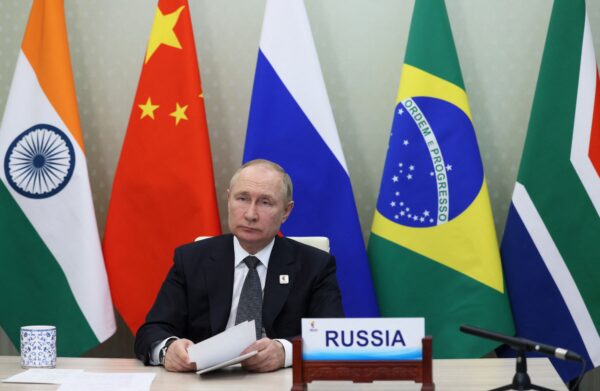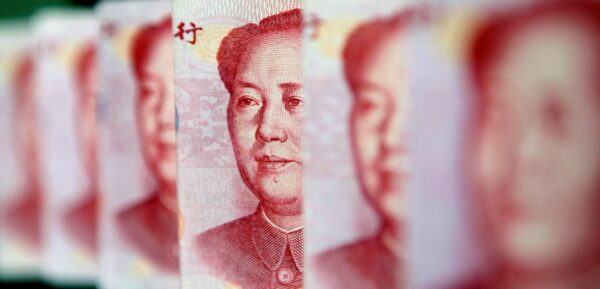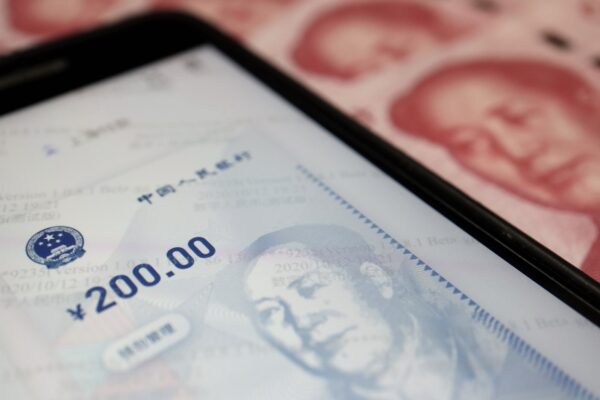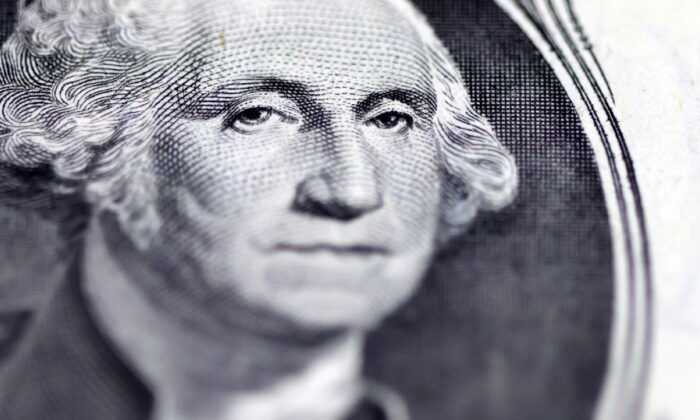Is the world challenging the U.S. dollar’s dominance?
Over the last decade, several nations worldwide, led primarily by Russia and China, have ramped up efforts to kick their dependence on the chief international reserve currency. From diminishing the prevalence of non-dollar transactions to reducing dollar holdings in foreign exchange reserves, states are employing measures to erode the buck’s influence in worldwide trade.
Jim O’Neill, a former chief economist at Goldman Sachs, suggested that the BRICS (Brazil, Russia, India, China, and South Africa) bloc should expand its presence and enhance the alliance’s work to threaten the greenback hegemony in global financial markets.
Writing in a March 26 paper in the Global Policy Journal, O’Neill championed adding new members to the group to bolster its objectives if these countries meet the initial criteria of maintaining large populations and have promising economies.
“The U.S. dollar plays a far too dominant role in global finance,” O’Neill wrote. “Whenever the Federal Reserve Board has embarked on periods of monetary tightening, or the opposite, loosening, the consequences on the value of the dollar and the knock-on effects have been dramatic.”
If the BRICS pact grows, it could facilitate the emergence of a multi-currency global financial system, he added.
Russia’s Deputy Chairman of the State Duma Alexander Babakov championed the proposal of the BRICS partnership producing its own currency.
“Its composition should be based on inducting new monetary ties established on a strategy that does not defend the U.S.’s dollar or euro, but rather forms a new currency competent of benefiting our shared objectives,” he recently told the St. Petersburg International Economic Forum event in New Delhi, India.
South Africa will host the 15th annual BRICS Summit from Aug. 22–24.
Last year, Russian President Vladimir Putin revealed in an address to BRICS Business Forum participants that “creating the international reserve currency based on the basket of currencies of our countries is under review.”

“I would like to stress that the Russian strategy does not change: while strengthening our economic, technological and scientific potential, we are ready to openly work with all fair partners on principles of respect to interests of each other, unconditional supremacy of international law, and equality of countries and peoples,” Putin said.
In the meantime, BRICS members are not waiting for a currency basket to compete against the dollar. Over the last year, many cases have occurred of China, Russia, and other partners engaging in cross-country trade settled in yuan, rubles, and other national currencies.
Post-Invasion Non-Dollar Acceleration
In May 2014, China and Russia fired the opening salvo in the de-dollarization initiative, signing the Agreement on Cooperation that would undercut the dollar’s position on top of the currency mountain.
But while this has been a decade-long affair, the de-dollarization efforts have accelerated since Moscow’s invasion of Ukraine.
In the immediate fallout of the military conflict in Eastern Europe, the U.S. government also froze Russia’s dollar reserves, revealing that Washington could threaten foreigners’ dollar holdings if officials disapproved of another government’s actions. Another initial response was blocking Russia’s access to the Society for Worldwide Interbank Financial Telecommunication (SWIFT). Roughly 300 Russian banks and financial institutions used this banking communications platform.
JPMorgan Chase CEO Jamie Dimon warned that blocking Russia’s access to SWIFT would trigger “unintended consequences,” while Goldman Sachs purported that it would amplify the de-dollarization push.
“However, overuse of these powers could compel other actors to try to replace Dollar transactions, as Russia already did to some extent following earlier sanctions,” the bank said.
After facing a bombardment of Western-led sanctions and restrictions in 2014 amid the annexation of Crimea, the Kremlin invested in a SWIFT alternative called the SPFS (System for Transfer of Financial Messages).
China has also put together another SWIFT substitute called the Cross-Border Interbank Payment System (CIPS), which has been steadily growing since 2020. As of February 2023, CIPS has nearly 1,400 participants, processing about $13 trillion.
Brazil and China signed a significant March 29 agreement to ditch the U.S. dollar and settle trade and financial transactions in yuan and reals to “promote even greater bilateral trade and facilitate investment.”
This came one day after China completed its first purchase of liquefied natural gas (LNG) in the yuan. The transaction between China National Offshore Oil Corp. (CNOOC) and France’s Total Energies involved 65,000 tons of LNG sourced from the United Arab Emirates.
Chinese leader Xi Jinping announced in a December visit to Saudi Arabia that the country would take advantage of the Shanghai Petroleum and Natural Gas Exchange (SHPGX) to settle more oil and gas transactions in the yuan.
During his meeting with Xi, Putin confirmed that Moscow would support the use of the yuan in payments between Russia and African, Asian, and Latin American countries. Putin also encouraged more yuan-denominated bilateral trade.
Before the war broke out, ruble-yuan trade volumes were non-existent. Since then, however, bilateral ruble-yuan trade volumes have skyrocketed, touching as high as $200 billion at the end of 2022.
Cambodia and Iraq have confirmed they plan to conduct more trade in the yuan.

Speaking in a January interview with Bloomberg TV in Davos, Saudi Arabian Finance Minister Mohammed Al-Jadaan acknowledged that the kingdom is open to trading in currencies other than the greenback.
“There are no issues with discussing how we settle our trade arrangements, whether it is in the U.S. dollar, whether it is the euro, whether it is the Saudi riyal,” he said. “I don’t think we are waving away or ruling out any discussion that will help improve the trade around the world.”
“We enjoy a very strategic relationship with China, and we enjoy that same strategic relationship with other nations, including the U.S., and we want to develop that with Europe and other countries who are willing and able to work with us,” Al-Jadaan added.
There has been speculation that other countries could join this crusade after Saudi Arabia restored ties with Iran and Syria.
In January, Moscow and Tehran signed an agreement to connect Iran’s local interbank telecom system (SEPAM) with Russia’s SPFS. This came several months after the Iran Currency Exchange (ICE) listed the ruble-riyal trading pair, allowing the two markets to settle trade payments in these currencies.
Zongyuan Zoe Liu, a fellow for international political economy at the Council on Foreign Relations (CFR), posited that India could become a major ally in the anti-dollar axis.
“Although India has not been an enthusiastic advocate for such a de-dollarization partnership, it has developed ways to trade with Russia while bypassing sanctions,” she opined in March 2022.
India’s government has been considering a more permanent rupee trade settlement with Russia after seeing imports soar nearly 400 percent year-over-year in the April-to-December period. The two sides established a rupee-ruble exchange to complete Russian arms sales to avoid U.S. sanctions.
Gold and CBDCs
Could gold and central bank digital currencies (CBDCs) play a role in the de-dollarization blitzkrieg?
In 2022, central bank gold demand was the highest on record, with these institutions purchasing more than 1,100 tons of gold worth approximately $70 billion, according to the World Gold Council (WGC). This is a dramatic turnaround, as central banks have been largely net sellers for the last 30 years.
China acquired 62 tons of gold, raising its total to more than 2,000 tons for the first time. Other central bank buyers were Turkey (148 tons), Egypt (47 tons), Qatar (35 tons), Iraq (34 tons), India (33 tons), the United Arab Emirates (25 tons), and Oman (2 tons).
Central banks typically buy gold to balance their forex reserves, diversify their portfolios, and hedge against fiat currencies.
“Our most recent annual central bank gold survey highlights two key drivers of central banks’ decisions to hold gold: its performance during times of crisis and its role as a long-term store of value,” the WGC said in its report. “It’s hardly surprising then that in a year scarred by geopolitical uncertainty and rampant inflation, central banks opted to continue adding gold to their coffers and at an accelerated pace.”
For months, there has been widespread speculation that Russia and its allies were on the cusp of building a gold-backed stablecoin for foreign trade.
But while experts assert that these reports may have been overstated, the concept of CBDCs being used as a tool in the broader de-dollarization battle could be a reality.
China has led the global CBDC push, prompting other governments and central banks to speed up their currency digitization efforts. As a result, the digital yuan has been used in several major cities, with more than 261 million e-yuan wallets. However, Chinese officials have encountered a series of hurdles, including lackluster adoption and usage rates.
While there are many wallets, research has found that the average balance for individual wallets is practically nothing.
The other concern has been the paucity of foreign adoption, says the Center for Strategic and International Studies (CSIS).
“[I]ts failure to find a footing among foreign consumers seems to reflect the relative lack of use of both the digital and conventional yuan outside of China,” wrote CSIS’ Theodore Benzmiller. “And unless China is able to boost international trust in its political system and institutions, it is likely to stay that way.”
As Beijing attempts to bolster its presence among world currencies, CBDCs can, theoretically, support this initiative, says Jonathan Dharmapalan, the founder of eCurrency Mint Limited and a former senior partner at Deloitte’s consulting practice.
“China has for a long time wanted to become a world currency or a reserve currency. Will CBDCs help with that? For liquidity, we’ll have to see China’s intentions to make CBDC another lever enabling transactions. It’s no secret they’ve said that that’s what they want to do,” he told The Epoch Times.
CBDCs could also be effective in circumventing Western sanctions, although additional “steps need to happen,” Dharmapalan added.

Geopolitical observers assert that the Chinese-led aim appears to de-dollarize intra-Asian cross-border payments, which is garnering support in the region.
“Last year was marked by a flurry of activity by Asian central banks aimed at exploring how so-called wholesale CBDCs can be leveraged to advance their countries’ respective national interests by improving the efficiency of domestic and intra-regional financial flows,” noted Robert Greene, a non-resident scholar at the Carnegie Endowment for International Peace’s Technology and International Affairs Program.
Cambodia’s central bank officials purport that CBDCs can enhance de-dollarization and boost local currencies.
“Cambodia is still considered as a highly dollarised economy while most of the transactions are still cash-based. This could hinder the effective implementation of monetary policy as well as payment system development,” the National Bank of Cambodia (NBC) stated in a white paper.
Meanwhile, it is estimated that more than 100 countries are in some stage of working with CBDCs.
The European Commission announced it is coming up with a digital euro that would complement euro banknotes and coins. Canada has only launched a public consultation process so far. Indonesia intends to manufacture a digital rupiah in a three-phased approach. Brazil plans to release a CBDC in 2024. Russia and Japan will test a digital ruble and digital yen in April.
Overall, two-thirds of central banks surveyed (pdf) by the Official Monetary and Financial Institutions Forum (OMFIF) say they will issue a CBDC within the next decade.
Dollar King Dethroned?
After World War I, the U.S. dollar started displacing the British pound sterling as an international reserve currency. Following World War II, the international community established the Bretton Woods System, effectively anointing the U.S. dollar as the world’s reserve currency. At the time, the buck was backed by gold. In 1971, then-President Richard Nixon abolished the convertibility of dollars into gold. But this did not hurt the greenback’s appeal, as it has been a safe-haven asset for central banks and global investors for decades.
The U.S. Dollar Index (DXY), which measures the greenback against a basket of currencies, had also surged last year, thanks to the Federal Reserve’s quantitative tightening. This made imports of U.S. goods, particularly dollar-denominated commodities, more expensive in foreign markets.
According to the International Monetary Fund’s (IMF) Currency Composition of Official Foreign Exchange Reserves (COFER), the U.S. dollar still represented approximately 58 percent of world reserves in 2022, unchanged from the previous year. However, this is down from 72 percent at the start of the century.
At the same time, China might be attempting to undermine the U.S. economy as it reduces its holdings of Treasury securities. In January, Beijing’s U.S. debt holdings plunged about 17 percent year-over-year to $859 billion, down from $1.033 trillion, Treasury Department data showed.
Despite the growing number of nations willing to accept the yuan, Irina Tsukerman, a geopolitical analyst and president of Scarab Rising, thinks the “dollar will remain the currency of choice for the foreseeable future.”
“Asian and African states are concerned about stability; Africa, in particular, can ill afford speculative ventures,” she told The Epoch Times. “The experience with yuan is relatively novel and is seen as risky; in particular, all parties involved have concerns due to China’s history of manipulating currency value and overvaluing it.”
Many economic systems and institutions, such as the IMF and the World Bank, are still reliant on the dollar, Tsukerman added.
That said, should America lose its reserve currency status, “that would mean the end of the U.S. dollar,” warned Monica Crowley, former Assistant Secretary for Public Affairs for the U.S. Department of the Treasury.
“It’s really hard to overstate exactly how catastrophic the abandonment of the U.S. dollar would be as the world’s global reserve currency,” Crowley said in an interview with Fox News on March 25, adding that the country has “abused this privilege by wholly reckless monetary and fiscal policy for so many years.”
“If you think inflation is bad right now, just wait,” Crowley added. “But more importantly, we would lose our economic dominance, and we would lose our superpower status.”
E.J. Antoni, a research fellow for Regional Economics at The Heritage Foundation, believes that foreign dollar demand has “allowed the U.S. to export inflation, to spend beyond our means and leaving foreigners to soak up the extra.” If the dollars that traveled throughout the international marketplace returned home, they would compete with the trillions already in the country.
“If the de-dollarization progresses, what becomes of the trillions of dollars accumulated around the world since 1944?” he asked.
“At that point, hyperinflation will not be hyperbole,” Antoni noted.

